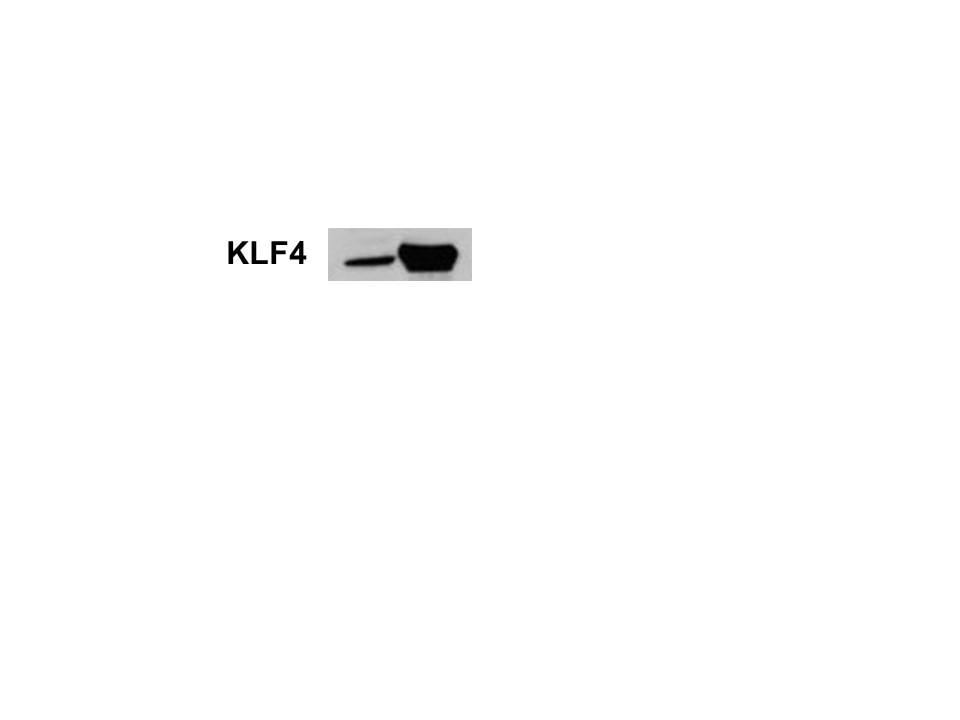Human KLF4 Antibody Summary
Ala2-Phe470
Accession # AAH29923
Applications
Please Note: Optimal dilutions should be determined by each laboratory for each application. General Protocols are available in the Technical Information section on our website.
Scientific Data
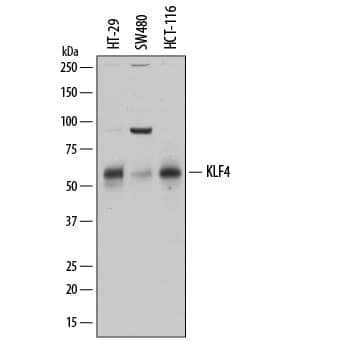 View Larger
View Larger
Detection of Human KLF4 by Western Blot. Western blot shows lysates of HT-29 human colon adenocarcinoma cell line, SW480 human colorectal adenocarcinoma cell line, and HCT-116 human colorectal carcinoma cell line. PVDF membrane was probed with 0.5 µg/mL of Goat Anti-Human KLF4 Antigen Affinity-purified Polyclonal Antibody (Catalog # AF3640) followed by HRP-conjugated Anti-Goat IgG Secondary Antibody (HAF109). A specific band was detected for KLF4 at approximately 60 kDa (as indicated). This experiment was conducted under reducing conditions and using Immunoblot Buffer Group 5.
 View Larger
View Larger
KLF4 in BG01V Human Stem Cells. KLF4 was detected in immersion fixed BG01V human embryonic stem cells using 10 µg/mL Goat Anti-Human KLF4 Antigen Affinity-purified Polyclonal Antibody (Catalog # AF3640) for 3 hours at room temperature. Cells were stained with the NorthernLights™ 557-conjugated Anti-Goat IgG Secondary Antibody (red; NL001) and counterstained with DAPI (blue). View our protocol for Fluorescent ICC Staining of Cells on Coverslips.
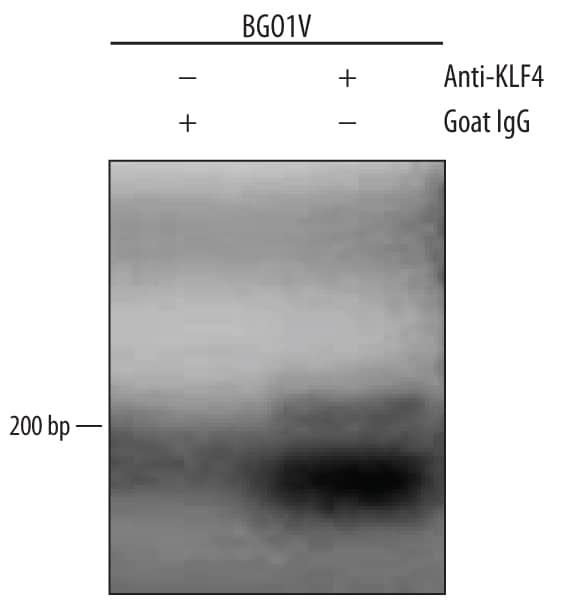 View Larger
View Larger
Detection of KLF4-regulated Genes by Chromatin Immunoprecipitation. BG01V human embryonic stem cells were fixed using formaldehyde, resuspended in lysis buffer, and sonicated to shear chromatin. KLF4/DNA complexes were immunoprecipitated using 5 µg Goat Anti-Human KLF4 Antigen Affinity-purified Polyclonal Antibody (Catalog # AF3640) or control antibody (AB-108-C) for 15 minutes in an ultrasonic bath, followed by Biotinylated Anti-Goat IgG Secondary Antibody (BAF109). Immunocomplexes were captured using 50 µL of MagCellect Streptavidin Ferrofluid (MAG999) and DNA was purified using chelating resin solution. TheB2Rpromoter was detected by standard PCR.
 View Larger
View Larger
KLF4 in Human Colon. KLF4 was detected in immersion fixed paraffin-embedded sections of human colon using 15 µg/mL Goat Anti-Human KLF4 Antigen Affinity-purified Polyclonal Antibody (Catalog # AF3640) overnight at 4 °C. Tissue was stained with the Anti-Goat HRP-DAB Cell & Tissue Staining Kit (brown; Catalog # CTS008) and counterstained with hematoxylin (blue). Specific labeling was localized to the nuclei of epithelial cells. View our protocol for Chromogenic IHC Staining of Paraffin-embedded Tissue Sections.
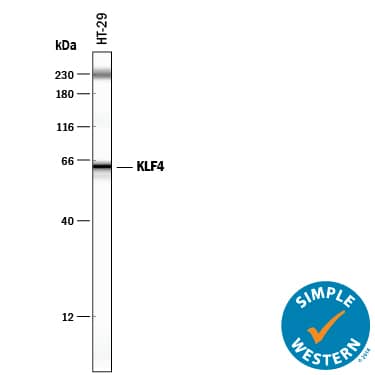 View Larger
View Larger
Detection of Human KLF4 by Simple WesternTM. Simple Western lane view shows lysates of HT-29 human colon adenocarcinoma cell line, loaded at 0.2 mg/mL. A specific band was detected for KLF4 at approximately 63 kDa (as indicated) using 25 µg/mL of Goat Anti-Human KLF4 Antigen Affinity-purified Polyclonal Antibody (Catalog # AF3640) followed by 1:50 dilution of HRP-conjugated Anti-Goat IgG Secondary Antibody (HAF109). This experiment was conducted under reducing conditions and using the 12-230 kDa separation system. Non-specific interaction with the 230 kDa Simple Western standard may be seen with this antibody.
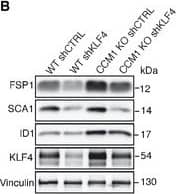 View Larger
View Larger
Detection of Mouse KLF4 by Knockdown Validated KLF4 regulates the EndMT switch in CCM1 KO ECsA–DCultured lung‐derived WT and CCM1 KO ECs were lentivirally transduced with shRNA directed to either Klf4 (shKLF4) or control sequence (shCTRL). (A) qRT–PCR of mesenchymal (Fsp1, Id1), stem cell‐like (Sca1), and endothelial markers (VE‐cadherin and Claudin5) in WT shCTRL, WT shKLF4, CCM1 KO shCTRL, and CCM1 KO shKLF4 ECs. Data are mean ± SD (n = 3). Fold difference in gene expression is relative to WT shCTRL ECs. A two‐tailed unpaired t‐test was performed. Klf4: ****P < 0.00001, ***P = 0.0008, **P = 0.007; Fsp1: ***P = 0.0001, ****P = 3.9E‐05, ###P = 0.0002; Sca1: ***P = 0.0001, ****P < 0.00001; Id1: ***P = 0.0001; Ve‐cadherin: ***P = 0.0001; Claudin5: ****P = 1.37E‐05. (B) WB of EndMT markers in WT shCTRL, WT shKLF4, CCM1 KO shCTRL, and CCM1 KO shKLF4 ECs. Vinculin is the loading control. These data are representative of three independent observations. (C) Proliferation rate of WT shCTRL, WTshKLF4, CCM1 KO shCTRL, and CCM1 KO shKLF4 ECs cultured for 5 days. Columns represent mean ± SD (n = 8). A two‐tailed unpaired t‐test was performed. 3 days of culture: ***P = 0.0001, **P = 0.0045, ##P = 0.0017; 5 days of culture: ***P = 0.0001, **P = 0.0029, ##P = 0.0040. (D) Migration rate measured in a wound assay of WT shCTRL, CCM1 KO shCTRL, and CCM1 KO shKLF4 ECs. Mean ± SD is shown (n = 6). A two‐tailed unpaired t‐test was performed. ***P = 0.0004, ###P = 0.0009.ECultured lung‐derived WT ECs were lentivirally transduced with a full‐length murine Klf4 (LentiKLF4) or empty vector (Mock). qRT–PCR (left panel) and WB (right panel) of EndMT markers in Mock and LentiKLF4 ECs. qRT–PCR data are mean ± SD (n = 3) and the fold changes are relative to Mock ECs. A two‐tailed unpaired t‐test was performed. **P = 0.002, ***P = 0.0007, ###P = 0.0001. WB results are representative of three independent observations. Tubulin is the loading control.Source data are available online for this figure. Image collected and cropped by CiteAb from the following publication (https://pubmed.ncbi.nlm.nih.gov/26612856), licensed under a CC-BY license. Not internally tested by R&D Systems.
 View Larger
View Larger
Detection of KLF4 in HT‑29 Human Colon Adenocarcinoma Cell Line (positive) and HDLM‑2 Human Hodgkin’s Lymphoma Cell Line (negative) Cells. KLF4 was detected in immersion fixed HT‑29 Human Colon Adenocarcinoma Cell Line (positive) and HDLM‑2 Human Hodgkin’s Lymphoma Cell Line (negative) Cells using Goat Anti-Human KLF4 Antigen Affinity-purified Polyclonal Antibody (Catalog # AF3640) at 5 µg/mL for 3 hours at room temperature. Cells were stained using the NorthernLights™ 557-conjugated Anti-Goat IgG Secondary Antibody (red; Catalog # NL001) and counterstained with DAPI (blue). Specific staining was localized to cytoplasm. View our protocol for Fluorescent ICC Staining of Cells on Coverslips.
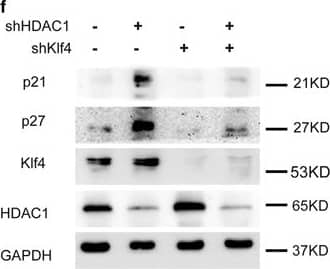 View Larger
View Larger
Detection of Human KLF4 by Knockdown Validated Klf4 significantly rescues the effects of HDAC1 on leukemia cell proliferation. (a) Effects of ectopic expression of Klf4 on HDAC1-induced cell proliferation. * and ** indicate P<0.05 and P<0.01, respectively. (b) FACS analysis showing the effects of ectopic expression of Klf4 on HDAC1-induced cell cycle. * and ** indicate P<0.05 and P<0.01, respectively. (c) CCK8 analysis showing the effects of Klf4 knockdown on HDAC1 deficiency-mediated cell proliferation. * and ** indicate P<0.05 and P<0.01, respectively. (d) FACS analysis showing effects of Klf4 knockdown on HDAC1 deficiency-mediated cell cycle. * and ** indicate P<0.05 and P<0.01, respectively. (e) Western blotting analyses showing the effects of ectopic expression of Klf4 and HDAC1 on the expression levels of p21 and p27. GAPDH was used as the loading control. (f) Western blotting analyses showing the effects Klf4 and HDAC1 knockdown on the expression levels of p21 and p27. GAPDH was used as the loading control. (g) ChIP-PCR assays showing Klf4 binding at the promoter region of p21 and p27 after HDAC1 knockdown. Control or HDAC1-deficient cells were fixed and subjected to ChIP assay with anti-Klf4 antibody. ChIP-PCR primers were used for p21 and p27 promoters where shown in Supplementary Table S2. *, **, and *** indicate P<0.05, P<0.01, and P<0.001, respectively Image collected and cropped by CiteAb from the following publication (https://www.nature.com/articles/cddis2014433), licensed under a CC-BY license. Not internally tested by R&D Systems.
Preparation and Storage
- 12 months from date of receipt, -20 to -70 °C as supplied.
- 1 month, 2 to 8 °C under sterile conditions after reconstitution.
- 6 months, -20 to -70 °C under sterile conditions after reconstitution.
Background: KLF4
Human KLF4, also known as epithelial zinc finger protein (EZF), is a 53 kDa (470 aa) member of the kruppel C2H2-type zinc finger protein family. It contains three C2H2-type zinc fingers at the carboxyl terminus that preferentially bind to cis-DNA elements that are GC rich. KLF4 regulates the expression of target genes that are involved in different cellular functions. KLF4 is highly expressed in the epithelial cells of the skin and the gastrointestinal tract. Human and mouse KLF4 share 90% amino acid sequence identity.
Product Datasheets
Citations for Human KLF4 Antibody
R&D Systems personnel manually curate a database that contains references using R&D Systems products. The data collected includes not only links to publications in PubMed, but also provides information about sample types, species, and experimental conditions.
44
Citations: Showing 1 - 10
Filter your results:
Filter by:
-
GC1qR Cleavage by Caspase-1 Drives Aerobic Glycolysis in Tumor Cells
Authors: Annika Sünderhauf, Annika Raschdorf, Maren Hicken, Heidi Schlichting, Franziska Fetzer, Ann-Kathrin Brethack et al.
Frontiers in Oncology
-
Inducible transgene expression in PDX models in vivo identifies KLF4 as a therapeutic target for B-ALL
Authors: Liu WH, Mrozek-Gorska P, Wirth AK et al.
Biomarker research
-
Maturation, not initiation, is the major roadblock during reprogramming toward pluripotency from human fibroblasts
Authors: Koji Tanabe, Michiko Nakamura, Megumi Narita, Kazutoshi Takahashi, Shinya Yamanaka
Proceedings of the National Academy of Sciences
-
SOX9 Governs Gastric Mucous Neck Cell Identity and Is Required for Injury-Induced Metaplasia
Authors: Spencer G. Willet, Nattapon Thanintorn, Helen McNeill, Sung-Ho Huh, David M. Ornitz, Won Jae Huh et al.
Cellular and Molecular Gastroenterology and Hepatology
-
Impact of cytosine methylation on DNA binding specificities of human transcription factors
Authors: Yimeng Yin, Ekaterina Morgunova, Arttu Jolma, Eevi Kaasinen, Biswajyoti Sahu, Syed Khund-Sayeed et al.
Science
-
Inhibition of the HEG1–KRIT1 interaction increases KLF4 and KLF2 expression in endothelial cells
Authors: Miguel Alejandro Lopez‐Ramirez, Sara McCurdy, Wenqing Li, Mark K. Haynes, Preston Hale, Karol Francisco et al.
FASEB BioAdvances
-
Smooth Muscle Cell Reprogramming in Aortic Aneurysms
Authors: Chen PY, Qin L, Li G et al.
Cell Stem Cell
-
The role of KLF4 in human primordial germ cell development
Authors: Lee, SM;Smela, MP;Surani, MA;
Open biology
Species: Human
Sample Types: Embryoid Bodies
Applications: Immunohistochemistry -
The mitochondrial protease ClpP is a druggable target that controls VSMC phenotype by a SIRT1-dependent mechanism
Authors: Paredes, F;Williams, HC;Liu, X;Holden, C;Bogan, B;Wang, Y;Crotty, KM;Yeligar, SM;Elorza, AA;Lin, Z;Rezvan, A;San Martin, A;
Redox biology
Species: Mouse
Sample Types: Tissue Homogenates
Applications: Western Blot -
Podocyte-specific KLF4 is required to maintain parietal epithelial cell quiescence in the kidney
Authors: JA Pace, R Bronstein, Y Guo, Y Yang, CC Estrada, N Gujarati, DJ Salant, J Haley, AB Bialkowska, VW Yang, JC He, SK Mallipattu
Science Advances, 2021-09-03;7(36):eabg6600.
Species: Mouse
Sample Types: Whole Tissue
Applications: IHC -
OCT4 cooperates with distinct ATP-dependent chromatin remodelers in na�ve and primed pluripotent states in human
Authors: X Huang, KM Park, P Gontarz, B Zhang, J Pan, Z McKenzie, LA Fischer, C Dong, S Dietmann, X Xing, PV Shliaha, J Yang, D Li, J Ding, T Lungjangwa, M Mitalipova, SA Khan, S Imsoonthor, N Jensen, T Wang, C Kadoch, R Jaenisch, J Wang, TW Theunissen
Nature Communications, 2021-08-26;12(1):5123.
Species: Human
Sample Types: Cell Lysates
Applications: Western Blot -
LncRNA DRAIR is downregulated in diabetic monocytes and modulates inflammatory phenotype via epigenetic mechanisms
Authors: MA Reddy, V Amaram, S Das, VS Tanwar, R Ganguly, M Wang, L Lanting, L Zhang, M Abdollahi, Z Chen, X Wu, S Devaraj, R Natarajan
JCI Insight, 2021-06-08;0(0):.
Species: Human
Sample Types: Cell Lysates
Applications: ChIP -
Chemical conversion of human epidermal stem cells into intestinal goblet cells for modeling mucus-microbe interaction and therapy
Authors: A Zhao, H Qin, M Sun, M Tang, J Mei, K Ma, X Fu
Science Advances, 2021-04-14;7(16):.
Species: Human
Sample Types: Whole Cells
Applications: ICC -
Expression of Components of the Renin-Angiotensin System by Cancer Stem Cells in Renal Clear Cell Carcinoma
Authors: S Siljee, B Milne, HD Brasch, N Bockett, J Patel, PF Davis, A Kennedy-Sm, T Itinteang, ST Tan
Biomolecules, 2021-04-07;11(4):.
Species: Human
Sample Types: Whole Tissue
Applications: IHC-P -
Loss of mucosal p32/gC1qR/HABP1 triggers energy deficiency and impairs goblet cell differentiation in ulcerative colitis
Authors: A Sünderhauf, M Hicken, H Schlichtin, K Skibbe, M Ragab, A Raschdorf, M Hirose, H Schäffler, A Bokemeyer, D Bettenwort, AG Savitt, S Perner, S Ibrahim, EL Peerschke, B Ghebrehiwe, S Derer, C Sina
Cellular and Molecular Gastroenterology and Hepatology, 2021-01-27;0(0):.
Species: Human
Sample Types: Cell Lysates, Whole Tissue
Applications: IHC, Western Blot -
Reprogramming competence of OCT factors is determined by transactivation domains
Authors: KP Kim, Y Wu, J Yoon, K Adachi, G Wu, S Velychko, CM MacCarthy, B Shin, A Röpke, MJ Arauzo-Bra, M Stehling, DW Han, Y Gao, J Kim, S Gao, HR Schöler
Science Advances, 2020-09-02;6(36):.
Species: Mouse
Sample Types: Cell Lysates
Applications: Western Blot -
GINS complex subunit 4, a prognostic biomarker and reversely mediated by Kr�ppel-like factor 4, promotes the growth of colorectal cancer
Authors: Z Rong, Z Luo, J Zhang, T Li, Z Zhu, Z Yu, Z Fu, Z Qiu, C Huang
Cancer Sci., 2020-03-17;111(4):1203-1217.
Species: Human
Sample Types: Whole Cells
Applications: ChIP -
Mitochondrial Protein Poldip2 (Polymerase Delta Interacting Protein 2) Controls Vascular Smooth Muscle Differentiated Phenotype by O-Linked GlcNAc (N-Acetylglucosamine) Transferase-Dependent Inhibition of a Ubiquitin Proteasome System
Authors: Paredes F, Williams HC, Quintana RA, San Martin A.
Circulation Research
-
p63 establishes epithelial enhancers at critical craniofacial development genes
Authors: E Lin-Shiao, Y Lan, J Welzenbach, KA Alexander, Z Zhang, M Knapp, E Mangold, M Sammons, KU Ludwig, SL Berger
Sci Adv, 2019-05-01;5(5):eaaw0946.
Species: Human
Sample Types: Cell Lysates, Whole Cells
Applications: ChIP, ICC, Western Blot -
Hominoid-Specific Transposable Elements and KZFPs Facilitate Human Embryonic Genome Activation and Control Transcription in Naive Human ESCs
Authors: J Pontis, E Planet, S Offner, P Turelli, J Duc, A Coudray, TW Theunissen, R Jaenisch, D Trono
Cell Stem Cell, 2019-04-18;0(0):.
Species: Human
Sample Types: Cell Lysates
Applications: ChIP -
Measles vector as a multiple genes delivery platform facilitating iPSC reprogramming
Authors: Q Wang, A Vossen, Y Ikeda, P Devaux
Gene Ther., 2019-02-04;0(0):.
Species: Human
Sample Types: Cell Lysates
Applications: Western Blot -
The TFAP2C-Regulated OCT4 Naive Enhancer Is Involved in Human Germline Formation
Authors: D Chen, W Liu, J Zimmerman, WA Pastor, R Kim, L Hosohama, J Ho, M Aslanyan, JJ Gell, SE Jacobsen, AT Clark
Cell Rep, 2018-12-26;25(13):3591-3602.e5.
Species: Human
Sample Types: Whole Cells
Applications: ICC -
AAVvector-mediated in vivo reprogramming into pluripotency
Authors: E Senís, L Mosteiro, S Wilkening, E Wiedtke, A Nowrouzi, S Afzal, R Fronza, H Landerer, M Abad, D Niopek, M Schmidt, M Serrano, D Grimm
Nat Commun, 2018-07-09;9(1):2651.
Species: Mouse
Sample Types: Whole Cells
Applications: ICC -
Kruppel-like factor 4 regulates keratinocyte senescence
Authors: E Panatta, AM Lena, M Mancini, M Affinati, A Smirnov, M Annicchiar, MC Piro, E Campione, L Bianchi, C Mazzanti, G Melino, E Candi
Biochem. Biophys. Res. Commun., 2018-03-26;0(0):.
Species: Human
Sample Types: keratinocytes
Applications: Western Blot -
Overlapping functions of Krüppel-like factor family members: targeting multiple transcription factors to maintain the naïve pluripotency of mouse embryonic stem cells
Authors: Mariko Yamane, Satoshi Ohtsuka, Kumi Matsuura, Akira Nakamura, Hitoshi Niwa
Development
Species: Transgenic Mouse
Sample Types: Cell Lysates, Transfected Whole Cells
Applications: Western Blot, Immunocytochemistry -
Data in support of sustained upregulation of adaptive redox homeostasis mechanisms caused by KRIT1 loss-of-function
Authors: C Antognelli, E Trapani, S Delle Mona, A Perrelli, C Fornelli, F Retta, P Cassoni, VN Talesa, SF Retta
Data Brief, 2017-12-13;16(0):929-938.
Species: Mouse
Sample Types: Cell Lysates, Whole Tissue
Applications: IHC-P, Western Blot -
HIF1? regulates single differentiated glioma cell dedifferentiation to stem-like cell phenotypes with high tumorigenic potential under hypoxia
Authors: P Wang, C Lan, S Xiong, X Zhao, Y Shan, R Hu, W Wan, S Yu, B Liao, G Li, J Wang, D Zou, B Chen, H Feng, N Wu
Oncotarget, 2017-04-25;8(17):28074-28092.
Species: Human
Sample Types: Cell Lysates, Whole Cells
Applications: ICC, Western Blot -
KLF2 and KLF4 control endothelial identity and vascular integrity
Authors: P Sangwung, G Zhou, L Nayak, ER Chan, S Kumar, DW Kang, R Zhang, X Liao, Y Lu, K Sugi, H Fujioka, H Shi, SD Lapping, CC Ghosh, SJ Higgins, SM Parikh, H Jo, MK Jain
JCI Insight, 2017-02-23;2(4):e91700.
Species: Human
Sample Types: Cell Lysates
Applications: Western Blot -
Induced overexpression of Oct4A in human dental pulp cells enhances pluripotency and multilineage differentiation capability.
Authors: Liu L, Wu L, Wei X, Ling J
Stem Cells Dev, 2015-01-08;24(8):962-72.
Species: Human
Sample Types: Whole Cells
Applications: ICC -
ZNF750 interacts with KLF4 and RCOR1, KDM1A, and CTBP1/2 chromatin regulators to repress epidermal progenitor genes and induce differentiation genes.
Authors: Boxer L, Barajas B, Tao S, Zhang J, Khavari P
Genes Dev, 2014-09-15;28(18):2013-26.
Species: Human
Sample Types: Cell Lysates, Whole Cells
Applications: ICC, Immunoprecipitation -
Lymphatic regulator PROX1 determines Schlemm's canal integrity and identity.
Authors: Park D, Lee J, Park I, Choi D, Lee S, Song S, Hwang Y, Hong K, Nakaoka Y, Makinen T, Kim P, Alitalo K, Hong Y, Koh G
J Clin Invest, 2014-07-25;124(9):3960-74.
Species: Human
Sample Types: Cell Lysates
Applications: ChIP -
KLF4 modulates expression of IL-6 in dendritic cells via both promoter activation and epigenetic modification.
Authors: Rosenzweig, Jason M, Glenn, Justin D, Calabresi, Peter A, Whartenby, Katharin
J Biol Chem, 2013-07-11;288(33):23868-74.
Species: Human
Sample Types: Cell Lysates
Applications: Mobility Shift Assay -
Endogenous Purification Reveals GREB1 as a Key Estrogen Receptor Regulatory Factor.
Authors: Mohammed H
Oncogene, 2013-02-09;3(2):342-9.
Species: Human
Sample Types: Cell Lysates
Applications: ChIP, Immunoprecipitation -
Innate immune suppression enables frequent transfection with RNA encoding reprogramming proteins.
Authors: Angel M, Yanik MF
PLoS ONE, 2010-07-23;5(7):e11756.
Species: Human
Sample Types: Whole Cells
Applications: ICC -
Heterozygous P32/C1QBP/HABP1 Polymorphism rs56014026 Reduces Mitochondrial Oxidative Phosphorylation and Is Expressed in Low-grade Colorectal Carcinomas
Authors: Annika Raschdorf, Annika Sünderhauf, Kerstin Skibbe, Berhane Ghebrehiwet, Ellinor I. Peerschke, Christian Sina et al.
Frontiers in Oncology
-
Proximity-dependent Mapping of the Androgen Receptor Identifies Kruppel-like Factor 4 as a Functional Partner
Authors: Lauriane Vélot, Frédéric Lessard, Félix-Antoine Bérubé-Simard, Christophe Tav, Bertrand Neveu, Valentine Teyssier et al.
Molecular & Cellular Proteomics
-
KRIT1 loss-of-function induces a chronic Nrf2-mediated adaptive homeostasis that sensitizes cells to oxidative stress: Implication for Cerebral Cavernous Malformation disease
Authors: Cinzia Antognelli, Eliana Trapani, Simona Delle Monache, Andrea Perrelli, Martina Daga, Stefania Pizzimenti et al.
Free Radical Biology and Medicine
-
HDAC1 and Klf4 interplay critically regulates human myeloid leukemia cell proliferation
Authors: Y Huang, J Chen, C Lu, J Han, G Wang, C Song et al.
Cell Death & Disease
-
Recurrent somatic mutations in POLR2A define a distinct subset of meningiomas
Authors: Victoria E Clark, Akdes Serin Harmancı, Hanwen Bai, Mark W Youngblood, Tong Ihn Lee, Jacob F Baranoski et al.
Nature Genetics
-
Mitochondrial Protein Poldip2 (Polymerase Delta Interacting Protein 2) Controls Vascular Smooth Muscle Differentiated Phenotype by O-Linked GlcNAc (N-Acetylglucosamine) Transferase-Dependent Inhibition of a Ubiquitin Proteasome System
Authors: Paredes F, Williams HC, Quintana RA, San Martin A.
Circulation Research
-
Structurally-discovered KLF4 variants accelerate and stabilize reprogramming to pluripotency
Authors: Evgeniia Borisova, Ken Nishimura, Yuri An, Miho Takami, Jingyue Li, Dan Song et al.
iScience
-
Kruppel-like factor4 regulates PRDM1 expression through binding to an autoimmune risk allele
Authors: Su Hwa Jang, Helen Chen, Peter K. Gregersen, Betty Diamond, Sun Jung Kim
JCI Insight
-
PGC1 alpha Regulates the Endothelial Response to Fluid Shear Stress via Telomerase Reverse Transcriptase Control of Heme Oxygenase-1
Authors: Shashi Kant, Khanh-Van Tran, Miroslava Kvandova, Amada D. Caliz, Hyung-Jin Yoo, Heather Learnard et al.
Arteriosclerosis, Thrombosis, and Vascular Biology
-
Overlapping functions of Krüppel-like factor family members: targeting multiple transcription factors to maintain the naïve pluripotency of mouse embryonic stem cells
Authors: Mariko Yamane, Satoshi Ohtsuka, Kumi Matsuura, Akira Nakamura, Hitoshi Niwa
Development
FAQs
No product specific FAQs exist for this product, however you may
View all Antibody FAQsIsotype Controls
Reconstitution Buffers
Secondary Antibodies
Reviews for Human KLF4 Antibody
Average Rating: 4 (Based on 1 Review)
Have you used Human KLF4 Antibody?
Submit a review and receive an Amazon gift card.
$25/€18/£15/$25CAN/¥75 Yuan/¥2500 Yen for a review with an image
$10/€7/£6/$10 CAD/¥70 Yuan/¥1110 Yen for a review without an image
Filter by:
